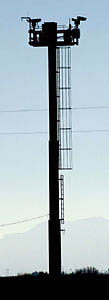

The geographic borders of the United States (that is, the "lines" between the US and Canada and the US and Mexico) are very, very long, around 6,000 miles in total. These borderlines go through a great many isolated and sometimes uninhabitable areas. As a result, it's virtually impossible for the federal agency tasked with patroling those borders (formerly the much-maligned Immigration and Naturalization Service, and currently the Bureau of Customs and Border Protection, a division of the newly created Department of Homeland Security) to "secure" each and every mile against all the smugglers, drug dealers, illegal immigrants and terrorists who are forever trying to enter America only to exploit or destroy it. The US's borders will be "porous," no matter how militarized they are made by Homeland Security, the Drug Enforcement Administration (DEA) or the Defense Department (DOD).
Good cases in point are the 235 different video surveillance systems currently in operation along America's borders. Two of these systems -- a 26-camera surveillance system in Douglas, Arizona, and a 32-camera system in Blaine, Washington -- were designed and installed in the late-1990s by the International Microwave Corporation (IMC), a Connecticut-based defense contractor. Since its founding in 1961, IMC has made wireless surveillance and communication devices for such government clients as Customs, the DOD, the DEA, the Federal Aviation Administration and the Canadian Coast Guard. The Department of Justice announced in 2002 that IMC has been awarded a brand-new $200 million contract for the installation of more surveillance systems along the US's borders.
The cameras in these systems cost $250,000 each; not surprisingly, they are quite different from the cameras one sees every day in cities such as New York. These are truly long-range ("tele-visual") cameras, capable of reading license plates on cars stopped two miles away, and detecting and tracking human movement three miles away. To increase their range and to protect them from floods, animals and human saboteurs, these cameras are installed at the tops of very tall towers, which are themselves fenced off. The movements of these cameras (pan, tilt and zoom) can be adjusted by remote-control from two miles away. These cameras are installed in pairs, with one devoted to "traditional" video (visible light), the other to thermal or "infrared" imaging. (Visible-light cameras have lenses made out of glass, while thermal cameras have lenses made out of metal.) In theory, the watchers can use their cameras to see during the day or night and in all weather conditions.
Using microwave transmitters, these cameras relay the images that they are capturing to towers erected at central monitoring stations. From these stations, at which all transmissions are recorded, mobile border patrol units can be alerted by radio-link or cellphone. Some of these mobile units (the video vans) can also be equipped with microwave transmitters, and weird and sometimes downright scary-looking surveillance cameras.
Despite their incredible cost, these systems -- just like Uninhabited Aerial Vehicles, which the Patrol Border, in cooperation with the Marines, started using back in 1999 -- are besieged with serious weather-related problems. Rainwater doesn't adequately drain from the electrical vaults; the infra-red cameras and the remote controls don't work if the temperature goes above 68-degrees Fahrenheit, which is a fairly common phenomenon all year long along the US-Mexico border. According to one report, the cameras aren't working 95 percent of the time! They are a vast waste of money, and should be taken down immediately.
By e-mail SCP@notbored.org
By snail mail: SCP c/o NOT BORED! POB 1115, Stuyvesant Station, New York City 10009-9998